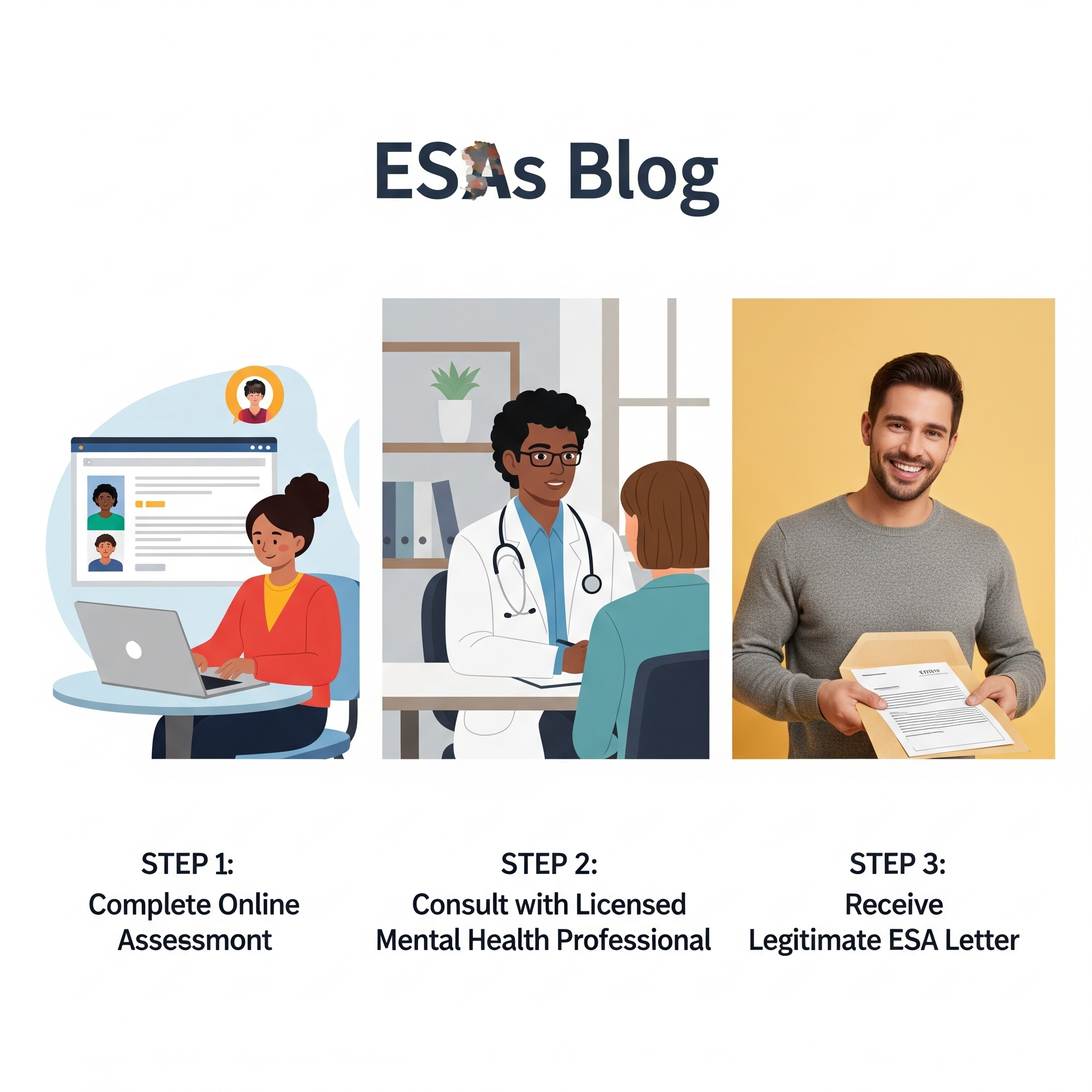Navigating the Complexities of Emotional Support Animals in the Workplace
For many individuals living with mental health conditions, an Emotional Support Animal (ESA) provides invaluable comfort and stability, helping to mitigate symptoms and improve overall well-being. While federal laws like the Fair Housing Act (FHA) offer clear protections for ESAs in housing, the question of “Can I bring my ESA to work?” is far more nuanced and lacks the same straightforward legal guarantees.
At CertifyESA, we empower individuals by connecting them with licensed mental health professionals for legitimate ESA letters, which are primarily recognized for housing. While we understand the profound bond and therapeutic benefits of an ESA, it’s crucial to distinguish workplace accommodations from housing accommodations. This blog will explore the legal landscape, potential avenues for bringing your ESA to work, and the key considerations involved.
The Legal Landscape: ADA vs. FHA
The primary federal law governing workplace accommodations for individuals with disabilities is the Americans with Disabilities Act (ADA). This is a critical distinction from the Fair Housing Act (FHA), which covers housing.
The ADA and Service Animals
-
Definition of Service Animal: The ADA defines a “service animal” as a dog (or in some cases, a miniature horse) that is individually trained to do work or perform tasks for the benefit of an individual with a disability, including a psychiatric disability (U.S. Department of Justice, 2020a). These tasks must be directly related to the person’s disability.
-
Public Access Rights: Under the ADA, businesses, including workplaces, must permit service animals to accompany individuals with disabilities in all areas where the public is normally allowed to go. This is why Psychiatric Service Dogs (PSDs), which are task-trained, are generally allowed in workplaces if their presence is a reasonable accommodation for the handler’s disability and they are well-behaved.
-
No ESA Recognition: Crucially, the ADA does not recognize Emotional Support Animals as service animals. This means that ESAs do not have the same automatic right of access to public places, including workplaces, that service animals do (U.S. Department of Justice, 2020a).
The Fair Housing Act and ESAs
-
Housing Accommodations: The FHA, enforced by HUD, requires housing providers to make reasonable accommodations for individuals with disabilities who need an ESA to use and enjoy their dwelling (U.S. Department of Housing and Urban Development, 2020). This is where your ESA letter from a licensed mental health professional is legally powerful.
-
Limited Scope: The FHA’s protections do not extend to the workplace. Your ESA letter, while vital for housing, does not automatically grant your ESA access to your place of employment.
Requesting a Reasonable Accommodation in the Workplace
Despite the ADA not directly covering ESAs, you may still be able to bring your ESA to work by requesting a reasonable accommodation under the ADA. This is not an automatic right, but rather a request your employer must consider.
The process typically involves:
-
Having a Disability: You must have a qualifying disability under the ADA. This includes a physical or mental impairment that substantially limits one or more major life activities (U.S. Department of Justice, 2020b).
-
Requesting Accommodation: You must inform your employer of your disability and specifically request the accommodation of bringing your ESA to work. It’s usually best to make this request in writing to your HR department or direct supervisor.
-
Providing Documentation: Your employer may request documentation to substantiate your disability and the need for the ESA. This is where your ESA letter from a licensed mental health professional comes in. The letter should clearly state your disability and how the ESA helps mitigate its symptoms in the workplace context (e.g., reduces anxiety during stressful meetings, provides grounding during panic attacks, helps maintain focus).
-
Engaging in the “Interactive Process”: The employer and employee are expected to engage in a good-faith “interactive process” to determine if a reasonable accommodation can be made. This means discussing your needs, the animal’s role, and any potential challenges or alternative accommodations.
When a Workplace ESA Request Might Be Denied
Even with a legitimate disability and an ESA, an employer is not required to grant the accommodation if it would pose an “undue hardship” or “direct threat.”
Undue Hardship:
This means the accommodation would cause significant difficulty or expense for the employer. Examples might include:
- Significant Financial Cost: While most ESA accommodations are low-cost, an employer might argue undue financial burden in very specific, unusual circumstances.
- Fundamental Alteration of Operations: If the presence of the ESA would fundamentally change the nature of the business (e.g., a sterile lab environment where any animal presence compromises safety or research).
- Disruption to Other Employees: If another employee has severe, documented allergies to the animal, or a legitimate phobia, and no reasonable alternative accommodation can be found for either party. This is a common and complex scenario.
Direct Threat:
This means the ESA poses a significant risk to the health or safety of others that cannot be eliminated or reduced by reasonable accommodation. This must be based on objective evidence, not speculation.
- Uncontrolled Behavior: An ESA that is disruptive, aggressive, or not house-trained could be denied. Your ESA must be well-behaved and under your control.
- Hygiene Issues: The animal must be clean and free of parasites.
- Specific Work Environment Risks: If the animal’s presence would inherently pose a safety risk in a specific industrial, manufacturing, or food preparation environment.
It’s crucial: The employer cannot deny your request simply because they have a “no-pets” policy. Just as with housing, an ESA is not a pet under disability law.
Key Considerations for Bringing Your ESA to Work
If you plan to request bringing your ESA to work, consider these important factors:
-
Your Dog’s Temperament and Training: Is your ESA genuinely well-behaved, quiet, and non-disruptive? Can it lie calmly under your desk for hours? Is it fully house-trained? Will it interact appropriately with colleagues and clients? This is paramount. An unruly ESA will likely lead to denial and potential disciplinary action.
-
The Nature of Your Workplace:
- Office Environment: Generally more conducive to an ESA than a retail store, factory, or healthcare setting.
- Public-Facing Role: If your job involves constant interaction with the public, the presence of your ESA might need more discussion regarding potential distractions or reactions from clients.
- Sterile Environments/Food Service: These environments have much stricter rules regarding animal presence due to health and safety regulations.
-
Colleague Sensitivities: While not a direct reason for denial, the presence of colleagues with severe allergies or phobias is a significant factor. Your employer may explore alternative accommodations for you or the affected colleague (e.g., moving desks, air purifiers).
-
Your Employer’s Policies: Does your company already have a policy for service animals or other accommodations? Familiarize yourself with it.
-
Proof of Legitimacy: Your ESA letter from a licensed mental health professional is essential. It provides the documentation your employer needs to understand your disability and the therapeutic role of your ESA. Ensure it’s clear and current.
How CertifyESA Supports Your Journey
While CertifyESA cannot guarantee workplace accommodations (as this is at the employer’s discretion within ADA guidelines), we provide the foundational element: a legitimate ESA letter from a licensed mental health professional.
-
Proper Documentation: Our network of LMHPs can assess your mental health condition and, if appropriate, provide a comprehensive ESA letter. This letter serves as critical documentation to present to your employer when making a reasonable accommodation request.
-
Understanding the Distinction: We help you understand the legal differences between ESAs and PSDs, and how these distinctions apply in various contexts, including the workplace.
-
Ethical Practices: We adhere to ethical guidelines, ensuring that your ESA letter is legally sound and clinically justified, giving you the best possible standing when requesting workplace accommodations.
Remember, the ESA letter confirms your need for the animal due to a disability. It does not certify the animal’s training or behavior, which remain your responsibility.
Conclusion: A Pathway, Not a Guarantee
Bringing your Emotional Support Animal to work is not an automatic right like housing accommodations. However, it is a possibility under the Americans with Disabilities Act as a reasonable accommodation for your disability. The success of your request will depend on your ability to present a legitimate need, the nature of your workplace, your ESA’s behavior, and your employer’s willingness to engage in the interactive process.
Armed with a legitimate ESA letter from a licensed mental health professional (like those facilitated by CertifyESA) and an understanding of the legal framework, you can confidently approach your employer to discuss the possibility of your ESA joining you at work, ensuring your vital companion can continue to support your mental well-being throughout your day.
APA Formatted Citations:
U.S. Department of Justice. (2020a, July 1). Service animals. ADA.gov. Retrieved from https://www.ada.gov/resources/service-animals-2010-regulations/
U.S. Department of Justice. (2020b, February 24). A Guide to Disability Rights Laws. Retrieved from https://www.ada.gov/resources/disability-rights-guide/
U.S. Department of Housing and Urban Development. (2020, January 28). Assessing a person’s request to have an animal as a reasonable accommodation under the Fair Housing Act. Retrieved from https://www.hud.gov/sites/dfiles/FHEO/documents/HUD_Guidance_on_ESA_01-28-2020.pdf





